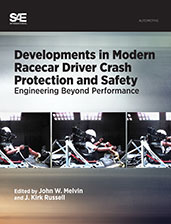Technical Paper
A Test Method to Assess Interactions and Compatibility of Inflatable Seatbelts with Child Restraint Systems
2017-03-28
2017-01-1448
Ford Motor Company introduced the automotive industry’s first second row inflatable seatbelt system in 2011. The system is currently available in the outboard seating positions of the second row of several Ford and Lincoln models. An important consideration for this system is the interaction with child restraint systems (CRS) when it is used to install a CRS or used in conjunction with belt position booster. A novel test methodology to assess the interaction of CRS with Ford and Lincoln inflatable seatbelts through frontal impact sled tests is explained. Details of test methods including construction of additional fixtures and hardware are highlighted. This procedure is designed to enable test labs capable of running Federal Motor Vehicle Safety Standard (FMVSS) 213 testing to adapt this test method, with minimal fabrication, by utilizing existing test benches.

